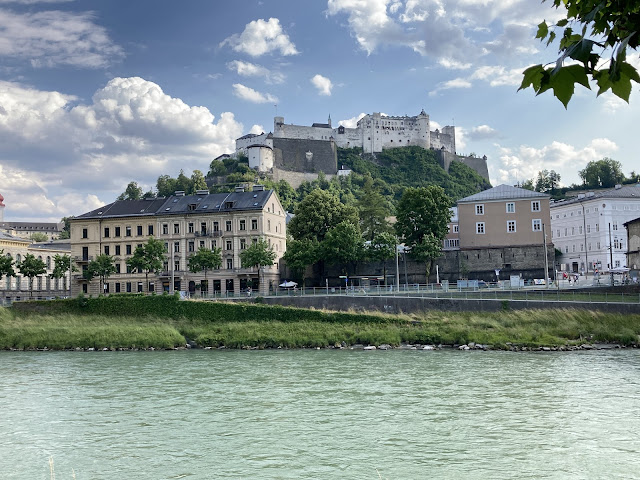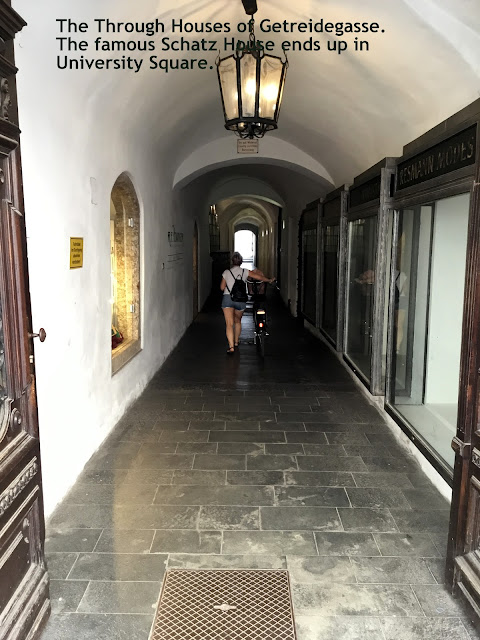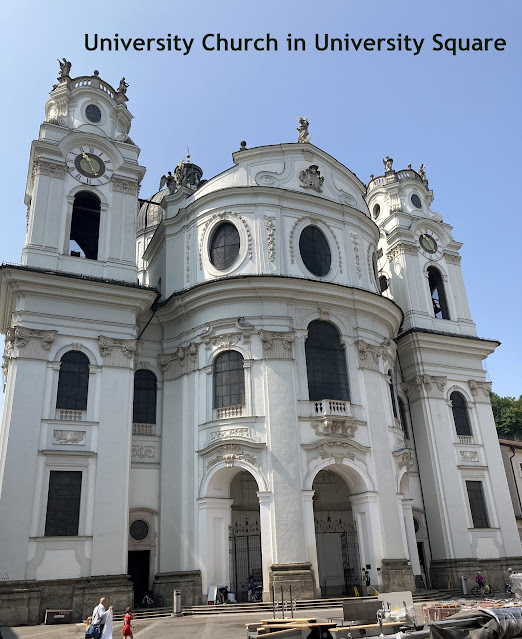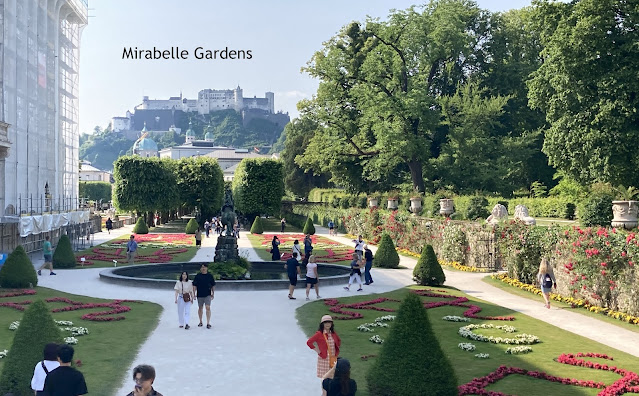Salzburg is
famous for many things and one of them is the Mirabell Gardens which are part of
the Mirabell Palace…. All under the UNESCO World Heritage tag. We had a
wonderful Japanese lady as our guide and she was a fount of knowledge. 
Besides
the Felsenreitschule and the Nonnberg convent, the Mirabell
Garden is one of the principal settings in the Hollywood musical The Sound of Music. In the film, Maria and the children dance
around the Pegasus fountain behind Mirabell Palace, singing the song
"Do-Re-Mi". At the end of this scene, the Trapp family line up on the steps leading to the
Rosenhügel [rose hill] for the finale. The unique view through the Mirabell
Garden to the Palace has since become world-famous. Prince-Archbishop Wolf Dietrich von Raitenau had the Palace (originally
called Schloss Altenau) built in 1606 for his mistress Salome Alt. His
successor, Marcus Sittikus re-named it as "Schloss Mirabell" [from
the Italian mirabile "wonderful" and bella "beautiful"].
Eventually, under Prince-Archbishop Franz Anton Harrach, the site was
reconstructed as a baroque palace complex.
Prince-Archbishop Wolf Dietrich von Raitenau had the Palace (originally
called Schloss Altenau) built in 1606 for his mistress Salome Alt. His
successor, Marcus Sittikus re-named it as "Schloss Mirabell" [from
the Italian mirabile "wonderful" and bella "beautiful"].
Eventually, under Prince-Archbishop Franz Anton Harrach, the site was
reconstructed as a baroque palace complex.

Under Archbishop Johann Ernst Thun, the Mirabell Garden was reshaped
around 1690 according to plans drawn up by baroque architect Johann Bernhard
Fischer von Erlach. The basic geometrical form characteristic of the Baroque
age is still recognisable. The visual alignment towards Cathedral and the
fortress lends the garden a grandiose effect, at the same time
incorporating it into the historic townscape.
Features of special interest in the Mirabell Garden
The large parterre with the central fountain
and the four groups of figures by Ottavio Mosto, symbolising the four elements:
fire, air, earth and water.
The small parterre with the Pegasus fountain.
The copper Pegasus figure, forged in 1661 by Caspar Gras, was commissioned by
Archbishop Guidobald von Thun for a horse-pond on the Kapitelplatz. After
gracing several different squares in the Old Town, the famous sculpture was
placed here in 1913.
 The Heckentheater [hedge theatre] in the
western section of the garden – one of the oldest hedge theatres north of the
Alps. Folkloric and other events are held here in summer.
The Heckentheater [hedge theatre] in the
western section of the garden – one of the oldest hedge theatres north of the
Alps. Folkloric and other events are held here in summer.
The Marmorsaal [marble hall], formerly the
prince-archbishop's banqueting hall, with its marble pillars, opulent stucco
and ceiling frescos is really awesome. Leading up to it is the "angels'
staircase", created by the Austrian sculptor Georg Raphael Donner. The
white marble balustrade is decorated with a host of putti.
When we entered this
building, the first thing which we noticed was a vast map of the city….but it
was part of the floor. Now imagine this sight with the photograph below. Thousands
of people have walked over the floor with this map on it but still nothing has
really damaged it. As you see, its pretty clear and very detailed. This must be
one of the really precious art works of the city just thrown under your feet !!
The Zwergerlgarten [dwarf garden] dates
from the reign of Archbishop Johann Ernst Graf Thun. Originally comprising
28 dwarfs of white Untersberg marble, it is the oldest dwarf garden in
Europe. 17 of the original dwarfs are still preserved.
Ensure that you have lots of time to enjoy the beauty of these gardens
and the buildings within.
Text and photographs copyright of the author. No part of this article or photographs maybe transmitted or reproduced by any means, electronic, mechanical, photocopying or otherwise, without written permission. Do contact the author on email -- helpthesun@gmail.com


























































